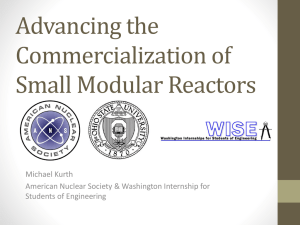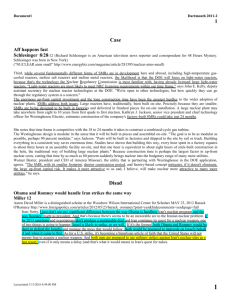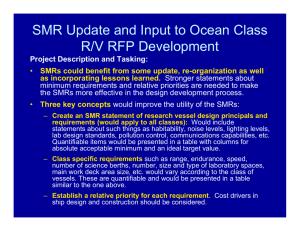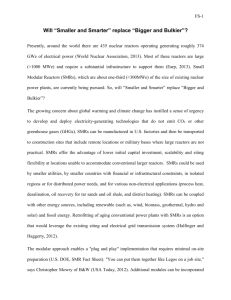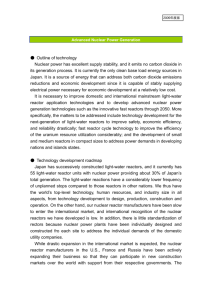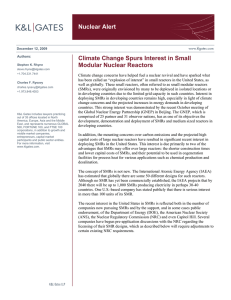Approaches to assess competitiveness of small and medium sized reactors
advertisement
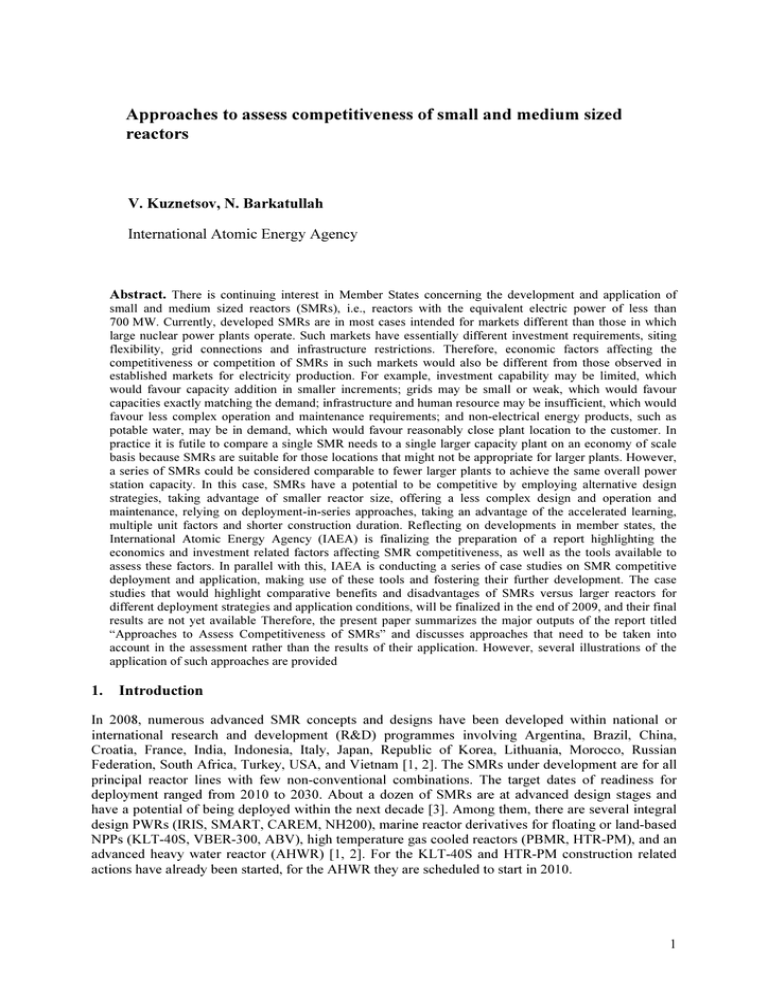
Approaches to assess competitiveness of small and medium sized reactors V. Kuznetsov, N. Barkatullah International Atomic Energy Agency Abstract. There is continuing interest in Member States concerning the development and application of small and medium sized reactors (SMRs), i.e., reactors with the equivalent electric power of less than 700 MW. Currently, developed SMRs are in most cases intended for markets different than those in which large nuclear power plants operate. Such markets have essentially different investment requirements, siting flexibility, grid connections and infrastructure restrictions. Therefore, economic factors affecting the competitiveness or competition of SMRs in such markets would also be different from those observed in established markets for electricity production. For example, investment capability may be limited, which would favour capacity addition in smaller increments; grids may be small or weak, which would favour capacities exactly matching the demand; infrastructure and human resource may be insufficient, which would favour less complex operation and maintenance requirements; and non-electrical energy products, such as potable water, may be in demand, which would favour reasonably close plant location to the customer. In practice it is futile to compare a single SMR needs to a single larger capacity plant on an economy of scale basis because SMRs are suitable for those locations that might not be appropriate for larger plants. However, a series of SMRs could be considered comparable to fewer larger plants to achieve the same overall power station capacity. In this case, SMRs have a potential to be competitive by employing alternative design strategies, taking advantage of smaller reactor size, offering a less complex design and operation and maintenance, relying on deployment-in-series approaches, taking an advantage of the accelerated learning, multiple unit factors and shorter construction duration. Reflecting on developments in member states, the International Atomic Energy Agency (IAEA) is finalizing the preparation of a report highlighting the economics and investment related factors affecting SMR competitiveness, as well as the tools available to assess these factors. In parallel with this, IAEA is conducting a series of case studies on SMR competitive deployment and application, making use of these tools and fostering their further development. The case studies that would highlight comparative benefits and disadvantages of SMRs versus larger reactors for different deployment strategies and application conditions, will be finalized in the end of 2009, and their final results are not yet available Therefore, the present paper summarizes the major outputs of the report titled “Approaches to Assess Competitiveness of SMRs” and discusses approaches that need to be taken into account in the assessment rather than the results of their application. However, several illustrations of the application of such approaches are provided 1. Introduction In 2008, numerous advanced SMR concepts and designs have been developed within national or international research and development (R&D) programmes involving Argentina, Brazil, China, Croatia, France, India, Indonesia, Italy, Japan, Republic of Korea, Lithuania, Morocco, Russian Federation, South Africa, Turkey, USA, and Vietnam [1, 2]. The SMRs under development are for all principal reactor lines with few non-conventional combinations. The target dates of readiness for deployment ranged from 2010 to 2030. About a dozen of SMRs are at advanced design stages and have a potential of being deployed within the next decade [3]. Among them, there are several integral design PWRs (IRIS, SMART, CAREM, NH200), marine reactor derivatives for floating or land-based NPPs (KLT-40S, VBER-300, ABV), high temperature gas cooled reactors (PBMR, HTR-PM), and an advanced heavy water reactor (AHWR) [1, 2]. For the KLT-40S and HTR-PM construction related actions have already been started, for the AHWR they are scheduled to start in 2010. 1 A few SMRs ready for immediate deployment (Canadian CANDU 6, Indian PHWRs, Chinese PWRs) or those developed for deployment within the next decade are in most cases intended for markets different from those in which large nuclear power plants operate - markets that value more distributed electrical supplies, a better match between supply increments and the investment capability and demand growth, or more flexible siting [4]. These markets have essentially different investment requirements, siting flexibility, grid connections and infrastructure requirements. Therefore, economic factors affecting the competitiveness or competition of NPPs in such markets would vary from those observed in established markets for electricity production. For example, an upfront lump-sum investment may be limited, which would favour capacity addition in smaller increments; grids may be small or weak, which would favour capacities exactly matching the demand; infrastructure and human resource may be insufficient, which would favour less complex operation and maintenance requirements; and non-electric energy products, such as potable water, may be in demand, which would favour reasonably close plant location to the customer. It is important that SMRs do not necessarily mean small or medium sized nuclear power station. Like any nuclear power plants, those with SMRs can be built several-at-a-site, or as twin units. From a practical standpoint it is not reasonable to compare a single SMR needs to single larger capacity plant on an economy of scale basis because SMR is suitable for those locations where larger plants cannot be constructed. It is more appropriate to compare a series of SMRs with fewer larger plants to achieve the same power station capacity. The units could then be incrementally added over time taking advantage of the effects of accelerated learning, multiple units, unit timing, construction schedule, as well as plant design, and create an investment profile with minimum capital-at-risk. All the above mentioned factors indicate that adequate assessment of SMR competitiveness is a complex task that may require considering investment profiles for a deployment scenario with several consequently built plants rather than conducting an economic assessment of just a single NPP. In this case, other factors in addition to the economy of scale would play a role such as, accelerated learning, sharing of facilities at a site, unit timing, and interest rate during construction. The assumption of constant expenditure and production profiles will not be appropriate and time-dependent profiles would need to be considered. In addition to this, uncertainty analysis is important for the determination of the investment risks as certain conditions are likely to change as the deployment scenario progresses. Also external factors and risks, as well as considerations of energy supply security need to be included in the overall assessment. 2. Suite of methodologies to assist designers and guide potential customers on the economic performance of SMRs When investing in reactor technology, the typical choice between a single SMR and a single large reactor might not be appropriate. A comparison between fewer larger reactor and a larger group of sequentially built SMRs, intended to yield the same aggregate power, or between a nuclear power option in general (large reactors or SMRs, whichever fits within a certain niche) and the competing non-nuclear energy technologies, such as gas, coal, hydro, renewables, etc., might be more befitting. This section will focus on the aspects that need to be taken into account when considering deployments of a larger number of smaller reactors versus smaller number of larger reactors. The methods described are generic and applicable to reactors of any size. 2.1. The G4-ECONS economic evaluation methodology for Generation IV systems: Since most of SMR technology is currently under development, the economic data does not yet exist or is not available at a fine enough level of detail to perform the complex comparative analyses normally associated with “business models.” 2 Accordingly, a simplified approach known as the levelized unit electricity cost (LUEC), which yields the electricity cost in US$/MW-hour, could be useful in this case. A state-of-the-art example of this approach is represented by the G4-ECONS model [5]. Being a simple measure, the LUEC can be employed as a benchmark to compare competing reactor technologies both among themselves and in regard to alternative energy sources. It also provides a concrete figure of merit which enters into several of the methodologies described later in this paper. However, while the LUEC is useful for comparisons between single reactors, it by itself not sufficient to analyze deployment strategies with different numbers of different reactors, e.g., for comparing a group of SMRs deployed in a series to a single large reactor. The reason being, the LUEC model assumes constant expenditures and production (see Fig. 1) – an assumption not suitable when several reactors are being deployed in a sequence. In the latter case, time dependent expenditures and production need to be taken into account. 2.2. Present value capital cost (PVCC) model: The LUEC models can be used in conjunction with other models that cater for other economic factors (accelerated learning, multiple units, design, construction, and timing), other than only economies of scale. Such models could be called present value capital cost (PVCC) models. For example, if smaller NPP units are constructed sequentially to achieve the same overall nuclear power station capacity, with all factors taken into account properly, a higher specific capital cost of a smaller reactor will not necessarily result is a higher LUEC for a combination of such reactors, when compared to a single larger plant of the same capacity, see Fig. 2. FIG. 1. Actual versus levelized costs in the G4-ECONS model [5]. To capture the economic benefits of the associated effects of accelerated learning, timing, sharing, and construction schedule, the PVCC model has been developed recently by the Westinghouse Electric Company [6]. This model is complementary to the LUEC model, and it is recommended that both models are used in collaboration to conduct economic assessments of SMRs. 3 Cost per KW(e) 1 2 Multiple Unit 3 Learning Curve 4 Construct Schedule 5 Unit Timing 6 Plant Design 0 (1) Economy of Scale - – Assumes single unit and same LR design concept (large plant directly scaled down) (2) Multiple Units –Cost – savings for multiple units at same site (3) Learning – Cost reductions for site & program learning for additional units in series (4) Construction Schedule - Reduced IDC from shorter construction time (5) Unite Timing - Gradual capacity additions to fit demand Present Value Capital Cost “SMR Concept” 300 600 900 1,200 Plant capacity (MW(e)) 1,500 FIG. 2.Potential SMR cost factor advantages included in PVCC model [6]. To demonstrate the economic competitiveness of SMRs in comparison to large reactors, the methodology [6] was applied to a case study for two power stations of the same total power, an SMR based power station consisting of four 300 MW(e) units built sequentially was compared to the power station with a single large reactor of 1200 MW(e). The SMR unit timing was assumed to match the selected load demand growth which required the equivalent of one SMR unit constructed every 9 months, see Table I. A discount rate of 5% per year was used for all results. The results of the calculations are given in Table II below. It can be seen that the specific capital cost of the SMR is 1.74 due to the economies of scale only. However, when the other factors are taken into account in the PVCC model, the cost actually shouldered by the utility, is only 1.04. In other words, for the considered case the four sequentially deployed SMRs compete nearly evenly with the single large reactor on a specific overnight capital cost basis. As the overnight capital cost is a critical component defining the difference in LUEC between a single small and a single large reactor, it could reasonably be assumed that the values of LUEC will be also close for this case. As it has been already mentioned, the case studies with the use of all described models are in progress currently, and they are expected to provide more details regarding the sample case of Table I and many other possible cases. Table I. Assumptions for the test case. SMR to large reactor 1:4 capacity ratio Scaled large reactor Based entirely on large reactor design scaled to 1:4 ratio cost SMR unit timing Discount rate 4 Every 9 months 5% per year Table II. Resulst of SMR capital cost factor model Capital cost factor Capital cost factor ratio (Four SMRs versus single large reactor, see Table I) Total capital investment cost Present value capital cost 0.78 0.78 0.78 (4)Construction schedule N/A 0.94 0.94 (6) Design specific factor 0.85 0.85 0.85 Overnight capital cost (1)Economy of scale (2) Multiple units and (3) Learning (5) Unit timing Cumulative total 1.74 N/A 1.16 1.74 N/A 1.09 1.74 0.95 1.04 2.3. Methodologies for systematic assessment of reduced design complexity: Reactors are complex systems that have a high degree of interdependence among their components, therefore the direct cost savings achieved by design simplification may be offset by the costs of the necessary adjustments to interdependent components. As a result, the economic effects of design simplification should be assessed through a systematic analysis of all the interdependent design changes together with their economic consequences. However, because such a process is complex and expensive, it is quite common that many design modifications are a priori excluded from the analysis, substantially limiting the range of options considered. To include a greater range of options, what is required is a simplified screening method which avoids the expense of a thorough analysis, yet which retains sufficient complexity to track the interdependent design effects so that various design options can be intelligently ranked. A model has been developed by the CNEA (Argentina) [7], in which a simplified screening method retaining a sufficient degree of complexity is obtained by relating the following four elements: • • A competitive target (or figure of merit) such as LUEC, which is needed to compare the various options; A detailed feature cost scaling model, which is needed to track the effects of design changes on the main design variables of the proposed design alternatives. As an example, it may be necessary to know how condenser size, and hence condenser cost, scales with the thermal power; • A set of cost multiplication factors Ki,j, which give the new cost of a modified feature (feature i,j) as the product of its initial cost and the factor itself; and • A model that relates the design features and their associated costs to both the scaling variables (such as thermal power) and the figure of merit (LUEC). The model developed effectively deals with both, external values that refer to contextual factors, such as the interest rate, which are not under the control of the designer but which do affect the cost. The project values which, by contrast, include such items as plant lifetime and investment flow which are internal to the design process. The schematic flow of the model is shown in Fig. 3. 5 Overnight costs Competitive target dk $ Kg FE O&M KWh VAR O&M Costs O&M P FIX Project assumptions Project values External values FIG. 3. Schematic flow sheet illustrating the effects on the overall competitive target calculation of a single design change dk [7]. The model has shown good agreement with the data originated from advanced reactor designers not only for the cases when analyzed reactors belong to the same reactor line, e.g., water cooled reactors, but also for cases when changes involved transition to a different coolant type, e.g., from water to gas or from water to sodium. 2.4. Methodologies for analysis of competitive total investment risks based on stochastic methods The LUEC is generally accepted as a common figure of merit for the evaluation of design alternatives of nuclear power plants. Because LUEC calculations are used to support energy policy and investment strategy, however, a reasonably high degree of accuracy is required in such calculations. Such accuracy can prove illusive due to large uncertainties in the input variables. Indeed, costs of materials for nuclear power plants and other power plants may vary with time depending on the economic and financial situation changes. Prices for organic fuel show even higher degree of variation, they tend to rise periodically and then go down due to financial crises, etc. For this reason LUEC calculations performed with Monte Carlo method added to simulate the uncertainties would provide more accurate results than just analytical, best point estimates alone. Reference [8] illustrates the technique and provides an example of such calculations, see Fig. 4. 2.5. Scenario codes: Long-term and large-scale development scenarios of nuclear energy, including those with SMRs, would pose challenges related to timely availability of material, infrastructure, human, and financial resources, including fissile and fertile and other materials, enrichment and fuel reprocessing services, and waste storage and final disposal facilities. Such scenarios would also bring into full focus the safety, proliferation resistance, and environmental concerns associated with nuclear energy as a whole. Once the mass flow analysis is accomplished, it provides the basis for ancillary analyses, including the economic analysis which addresses the economic aspects of deployment of a large number of plants and associated nuclear infrastructure, including front-end and back-end fuel cycle facilities. It should be noted, however, that, because of the overall complexity of integral modelling, the economic models included in many of the MFA codes as essentially simplified, sometimes referred to as cash flow analysis models, or even not at all available [9]. 6 Number of results of random calculations 120 Coal Power Plant 100 80 60 Gas Power Plant 40 20 0 Nuclear Power Plant 4.0 4.5 5.0 5.5 6.0 6.5 7.0 7.5 8.0 Levelized Cost of Electricity, US$ cents/kWh FIG. 4. Distribution of LUEC from coal, gas and nuclear power plants [8]. Within IAEA, it is the International Project on Innovative Reactors and Nuclear fuel Cycles (INPRO) [9] that addresses the issues of long-term and large-scale global and regional nuclear energy expansion, see Fig. 5. While the deployment issues that require consideration are quite diverse, the kernel for most of the large-scale and long term scenario analyses rests on dynamical mass flow simulation. Mass-flow analysis (MFA) aims at analyzing all fissile and fertile material and other material mass-flows within the nuclear enterprise. MFA computer models are used to inter-compare nuclear deployment strategies by providing a full analysis of the mass-flows resulting from candidate strategies. They allow planners to assess the impact on resource and waste mass-flows of choosing between alternative options. 2.6. IAEA Methodologies and analytical tools: The IAEA has developed a set of analytical tools (models) that cover a wide spectrum of energy issues and provide a consistent framework for developing and evaluating alternative development paths for the energy system or a sub-system, allowing for expected changes in demography, life-styles, technological development and innovations, economic competitiveness, environmental regulations, market restructuring, and global and regional developments. These models are very flexible and easily adaptable to different situations, needs and applications in different countries. The models that are most applicable to assess the potential role and competitiveness of SMRs are MESSAGE and FINPLAN [10]. Both the models can be used interactively to conduct an integrated analysis. MESSAGE considers the full range of energy supply options together with all relevant infrastructure facilities and resources, including the capability to incorporate technical, economic, environmental, regulatory and policy constraints. It identifies an optimal portfolio of energy supply facilities that should be built/ expanded over time to meet the expected future energy demand, by minimizing the total energy supply cost. FINPLAN assists in evaluating the financial viability of the investment plan determined by MESSAGE analysis. The output from FINPLAN can be used to modify the inputs to MESSAGE, if the given financial resources do not support the MESSAGE proposed investment plan. Through an iterative procedure, a consistent set of scenarios for the development of energy supply facilities can be modelled. 7 World Tier - 1 Regional National Energy Energy Technology Technology Characterization Characterization Energy Energy Market Market Simulation Simulation Energy EnergyProduct Product Services Services Fossil-based Fossil-based conversion conversion technologies technologies Renewable Renewable conversion conversion technologies technologies Nuclear Nuclear conversion conversion technologies technologies Energy Energy Demand Demand Scenarios Scenarios Nuclear Nuclear Energy Energy Demand Demand Scenarios Scenarios Nuclear Nuclear Energy Energy System System Global Global Integrated Integrated Nuclear Nuclear Strategy Strategy Preferences Stakeholders, e.g. Multi-Attribute Analysis Regional Regional Integrated Integrated Nuclear Nuclear Strategy Strategy National National Integrated Integrated Nuclear Nuclear Strategy Strategy Sustainability Dimensions Economic Economic Social Social Environmental Environmental Institutional Institutional INS INS Technology Technology Economy Economy Safety Safety Waste Waste Mgt Mgt Non-Proliferation Non-Proliferation Infrastructure Infrastructure Sustainability Areas Tier - 2 FIG.5. Scope of energy development scenario analysis by the INPRO project [9]. MESSAGE is a very flexible analytical tool with the capability to model the whole energy system or parts of it, like power generation, including all available energy supply technologies, like large reactors, SMRs, coal, gas and renewables, see Fig. 6. RESOURCES SEN PRIMARY DEMAND Coal Transport & Distribution Gas Ind. Electricity SMR EElec. Ind. Hydro Power Primary Gas Gas Import Gas Power Plant Industrial Electricity Coal Power Coal Powe Coal Ind. Industrial Heat Coal Electricity Primary Coal Coal Resources Coal Extraction FINAL Electricity Transport & Distribution Gas Gas Transport & Distribution FIG. 6. A simple energy supply model in MESSAGE – physical flow [4]. To run MESSAGE, the initial stage is to prepare input data set describing the existing supply system, the expected future demand and load characteristics, the available energy resources, the possible technological options and any physical or policy related constraints. The model computes optimal supply projections depending on user specified objective function, i.e., least cost, minimum import dependent, lowest environmental impact, etc. FINPLAN helps assess the financial viability of plans and projects in general but it is particularly useful in developing countries where financial constraints are often the most important obstacle to 8 implement optimal electricity expansion plans. It is designed to evaluate the financial implications of an expansion plan for a power generating system, of all technology types, like coal, gas or nuclear power, including SMRs. If the expansion plan is too ambitious for available resources, even the most efficient (least-cost) configuration may not be achievable. Such financial constraints may require a revision of the economically optimum expansion plan. FINPLAN helps to analyze alternative expansion plans by evaluating their financial consequences. The main inputs and outputs of FINPLAN are shown in Fig. 7. With their technical details and flexibility capabilities, MESSAGE and FINPLAN appear an excellent set of tools for energy expansion planning in member states. Comprehensive training programmes are being continuously provided by the IAEA to assist member states to understand and usefull employ the models to their advantage. OUTPUT INPUT For each year: Investment programme (<= capacity additions) & operating expenses Economic and fiscal parameters (inflation, escalation, exchange rates, taxes) Financial parameters (credits, bonds…) FINPLAN $ Cash flows Balance Sheet, Statement of Sources, Applications of Funds Financial Ratios: - Working Capital Ratio - Leverage ratio - Debt Repayment Ratio -… - Global Ratio FIG. 7. Main inputs and outputs of FINPLA [10]. 3. Methods under development economic and investment analysis being developed within IAEA project “Common Technologies and Issues for SMRs” [11] is described in brief below. The principal contributors to this development are the Politecnico di Milano and ENEA (Italy) and the Westinghouse Electric Company (USA). The proposed approach attempts to bring together all currently available state-of-the-art models for generation costs, revenues, financial costs, and external factors and risks, while “keeping the door open” for any new approach or development once it becomes available. The open model is being developed for a specific task of comparing the deployments of SMRs versus larger reactors in liberalized energy markets. As it was already noted, SMRs might have several economic advantages with respect to larger reactor which can compensate for their disadvantages with respect to scale. These advantages result from the enhanced qualities of replication, scalability, reversibility, and standardization: • • Replication provides economies of learning in which suppliers, utilities, and contractors become progressively more efficient at the same tasks. The example is the effect of accelerated learning; Scalability refers to the advantages that SMRs may have with regard to siting, timing, and sizing due to their compact or modular design. With respect to location, co-siting allows more reactors to be installed on the same site so that the fixed costs for land, site qualification, etc. are zero for the second and all subsequent units. With respect to timing, the short construction time of smaller reactors may allow the financial investment to be deferred until shortly before the plant becomes operational. This would save interest charges and, therefore, lower the average cost. The advantage of sizing results from the fact that investors can expand their 9 • • capacity incrementally and rapidly to match market conditions. Scalability could be an advantage in certain markets because the rate of expansion can be then adjusted to meet high, medium, or low demand growth; Reversibility, by contrast, is an advantage in uncertain markets. Reversibility refers to the ability of utilities to “reverse the course” and stop expansion immediately to match a sudden slackening in market demand. Like scalability, reversibility also results from the sizing which allows for small commitments of capital at the point of operation instead of large commitments of capital several years in advance. As a result, SMR technology could be less financially risky than that of large reactors, and this fact should result in lower interest rates since the investors can “hedge their bets”; Standardization brings the benefits of learning economies, such as replication, and technical progress economies which result from the continuous marginal improvements experienced by a common line of production technology over a long period of time. While these several advantages lower the cost of SMR technology, whether they suffice to make SMRs economically competitive with large reactors is, however, a contextually dependent question. Some answers to this question are expected to be available by the end of 2009, when the already mentioned case studies conducted by IAEA will be finalized. The consolidated approach being developed [11] includes the investment model that contains three sub-models, which are the generation cost model, the revenue model, and the financial model. There is also a model for “other factors” (external factors model) which deals with such factors as those of the regulatory and socio-political environment. These factors are often volatile and exert an external effect on the investment. The data from these two models is synthesized via a multi-attribute evaluation model which uses the analytical hierarchy process (AHP) to blend the quantitative data coming from the investment model with the qualitative data derived from the model for “other factors”, see Fig. 8. The overall open model includes provisions for uncertainty analysis and simplicity of use. FIG. 8. Framework of a general model for investment evaluation [11]. LUEC will be an important figure of merit in this model; however, provisions would be made to ensure that LEUC is calculated taking into account time-dependent expenditure and production profiles and changing interest rates. In addition models to calculate investment profiles and revenues will be included. Finally, an approach to take into account other factors potentially affecting the competitiveness of SMRs, such as energy supply security, proliferation-resistance, political posture, etc. will be developed. As an example, Fig. 9 shows the comparative time dependent cash flows for the case study described earlier in the paper, see Tables I and II. It can be seen that, when compared to a deployment of a single large reactor of the same capacity, staggered build of SMRs may minimize negative cash flow (capital-at-risk) but also may delay full site power availability to the grid and lower 10 the net present value of the project by shifting cash inflows onward. More comparative case studies of this kind are ongoing currently, and their results would become available by the end of 2009. FIG. 9. Cumulative cash flow for the case study defined by Tables I and II: staggered build of 4 SMRs versus one large reactor of the same overall capacity [11]. The framework of an open model for the SMR economic and investment analysis is partly implemented as a software package. Further development of the open model is focused on examining the capability of each of the sub-models to take into account the advantages and disadvantages related to replication, scalability, reversibility, and standardization. The updated versions of the software are used in case studies of SMR competitiveness in different applications, carried our within the IAEA project “Common technologies and issues for SMRs”. 4. Concluding remarks Adequate comparative assessment of SMR competitiveness is a complex task that may require considering time dependent expenditure and generation profiles and interest rates to determine adequate values of LUEC for deployment scenarios with several consequently built plants of different types and capacities. As private capital may play an important role in financing of the new plants, investment and revenue models need to be employed to determine time-dependent characteristics, such as investments and revenues. Uncertainty analysis needs to be incorporated to add a degree of fidelity to the overall assessment. A variety of methods and tools required to conduct comparative economic assessments have been described in this paper. Many of these tools already exist in member states or are available from international organizations. In addition to this, the IAEA coordinated the development of an open model for the analysis of SMR economic and investment opportunities, which targets bringing together all currently available state-of-the-art models for generation costs, revenues, financial costs, and external factors and risks, while “keeping the door open” for any new approach or development once it becomes available. The open model is being developed for a specific task of comparing the deployments of SMRs versus larger reactors in liberalized energy markets. LUEC will be an important figure of merit in this model; however, provisions would be made to ensure that LEUC is calculated taking into account time-dependent expenditure and production profiles and changing interest rates. In addition models to calculate investment profiles and revenues will be included. Finally, an approach to take into account other factors potentially affecting the competitiveness of SMRs, such as energy supply security, proliferation-resistance, political posture, etc. will be developed. In parallel with the development of such model, IAEA is conducting a series of case studies to indentify options for SMR competitive deployment and relative benefits and disadvantages of smaller and larger reactors in different deployment strategies and application conditions. Full results of these studies, preformed with the use of the currently available versions of the “open model” would be available by the end of 2009. 11 Apart from what has been said above, over the past decades several developing countries have developed a capability to design and manufacture SMRs indigenously, relying on local materials and local labour (the examples are India, China and, potentially, Argentina). Some of these designs offer attractive capital cost characteristics, resulting from higher purchasing power of hard currency in these countries. Should this capability be maintained and improved over time, such SMRs might become a good choice for less developed countries, offering a reasonable alternative to the larger more expensive plants produced in the developed countries. REFERENCES [1] INTERNATIONAL ATOMIC ENERGY AGENCY, Status of Innovative Small and Medium Sized Reactor Designs 2005: Reactors with Conventional Refuelling Schemes, IAEA-TECDOC-1485, Vienna (2006). [2] INTERNATIONAL ATOMIC ENERGY AGENCY, Status of Small Reactor Designs without On-site Refuelling, IAEA-TECDOC-1536, Vienna (2007). [3] INTERNATIONAL ATOMIC ENERGY AGENCY, Progress in Design and Technology Development for Innovative Small and Medium Sized Reactors, Attachment to Nuclear Technology Review 2007: http://www.iaea.org/About/Policy/GC/GC51/GC51InfDocuments/English/gc51inf-3att4_en.pdf [4] INTERNATIONAL ATOMIC ENERGY AGENCY, Approaches to Assess Competiveness of SMRs, IAEA Nuclear Energy Series Report (in preparation). [5] A User’s Manual for G4-ECONS. Generation IV Economic Modeling Working Group (May 2006). [6] Methodologies and Criteria for Demonstrating Competitiveness of SMRs – Present Value Capital Cost Model, Material submitted by Westinghouse Electric Company for a new IAEA Nuclear Energy Series Report “Approaches to Assess Competitiveness of SMRs (2007). [7] Methodologies for Systematic Assessment of Reduced Design Complexity, Material submitted by Westinghouse Electric Company (USA) for a new IAEA Nuclear Energy Series Report “Approaches to Assess Competitiveness of SMRs (2007. [8] FERETIC, D., TOMSIC, Z., Probabilistic analysis of electrical energy costs comparing production costs for gas, coal and nuclear power plants, Energy Policy 33 (2005). [9] INTERNATIONAL ATOMIC ENERGY AGENCY, Methodology for the assessment of innovative nuclear reactors and fuel cycles – Report of Phase 1B (first part) of the International Project on Innovative Reactors and Fuel Cycles (INPRO), IAEA-TECDOC-1434, Vienna (2004). [10] INTERNATIONAL ATOMIC ENERGY AGENCY, Expansion Planning for Electrical Generating System (A Guidebook), IAEA Technical Report Series TRS-141, Vienna, (1984). [11] An Open Model for the Evaluation of SMR Economic Attractiveness, Material submitted by Politecnico di Milano (Italy) for a new IAEA Nuclear Energy Series Report “Approaches to Assess Competitiveness of SMRs (2007). 12

